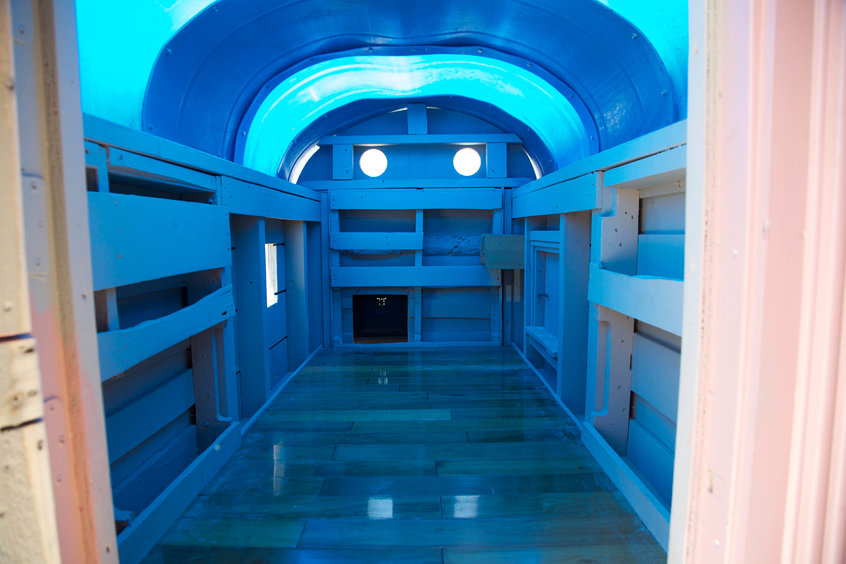An artist in Oakland, California, has begun making miniature homes for homeless people out of objects he finds in the street. Each has a build cost of between $30 and $40 – and at least one has already been sold on.
Gregory Kloehn makes his dwellings from illegally dumped waste such as pallets, plastic barrels, bedframes and washing machine doors, and takes care to add decorative features such as columns, imitation pantile roofs and front door steps.
The houses are just big enough to lie down in, and provide more protection and dignity than arrangements usually available to the homeless. Some users have added extensions.

All the houses come with decorative details
He got the idea for the homes from the shelters that street people built for themselves. He decided to do the same, but to make them as attractive as possible.
The only thing he spends money on is large caster wheels, which make the homes mobile – that and nails, screws and paintbrushes.
Kloehn wants others to follow his example. “Grab some garbage and go for it,” he urges on his website.

Some of the houses are more elaborate than others
“I would love it if other people would build these types of homes for their community! You don’t need anyone’s permission to help homeless people,” he writes, adding: “You just have to like to build.”
Kloehn started making the residences of rubbish in 2012 and it struck a chord. Following an article in a local newspaper he was inundated with emails from people wanting to help. “I thought that I should channel this good will,” he said.Â
Now he needs a bigger workshop: “As of now, people come to my shop and help me on the homes I already have in progress. Soon we are moving to a larger space that can accommodate workshops and larger builds.”Â

Artist Gregory Kloehn, looking for materials in Oakland
He also wants to take workshops on the road to reach different communities.
From first-hand experience Kloehn, 43, knows what’s needed in small, ad-hoc houses. He used to make homes from dumpsters, and for six months lived in one that he’d made in Brooklyn, New York (pictured). It has a toilet, stove, sink and bar and he uses it as his New York pied à terre.
For him it’s a project that can run and run. “With an endless supply of garbage and a large number of homeless,” he writes, “I know that I can keep busy for a while with the Homeless Homes. I’ve got a few new designs that I want to make with pallets and garbage.”Â
Common-sense approach
Homelessness is on a gradual downward trend in the US, but is still a significant problem, with over half a million people (578,424) sleeping rough across the country in January 2014, according to the National Alliance to End Homelessness.

Kloehn at work. “You just have to like to build,” he says
Kloehn may be driven by philanthropic creativity, but research suggests that he has actually hit upon a common-sense approach.
In a study last year, the state of Utah’s Housing and Community Development agency calculated that housing just one chronically homeless person generated around $8,000 net cost savings to taxpayer-funded community systems.
A similar study in Florida concluded that giving homeless people permanent housing and case managers would save taxpayers $149m over 10 years in reduced law enforcement and medical costs.

The fully plumbed in dumpster house Kloehn made in New York
Meanwhile, Kloehn has big ambitions for his debris dwellings. “I would love to make a functioning city from garbage,” he writes. “I must also finish up a project in New York using four shipping containers. Bikes, carts and dumpsters are objects that I think about a lot. The most important place for me to be next, is in my shop. That is where my ideas become reality.”
All photos courtesy of Brian J Reynolds.
Comments
Comments are closed.











The obvious way to go is to separate every last scrap of junk and or refuse via highly efficient recycling systems to localised recycling depots and thus in time eliminate the old refuse removal and hugely
polluting landfill sites! These depots would also take and separate all industrial demolition and production waste! In this way localised, ready and affordable access to sufficient building materials and even repairable
household furniture and appliances would be made possible! Students in training in all of the building trades and professions could then be engaged as a module of their practical training to design and build such shelters
for those most in need all as part of their community outreach program! In this way many thousands of otherwise homeless persons could find healthy shelter and relief the hash extremes of wind and weather!!
I think that’s brilliant. Excellent use of rubbish. One could also enlist the help of say disaffected youngsters to make a positive contribution and maube even make a home for themselves. As so frequently is the case, a solution to a problem, elegant in its simplicity. Bravo!
Commentates also possible that many of the homeless could assist in the building process…Gaining new skills and a sense of ownership and achievement